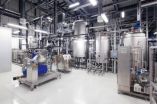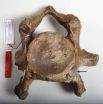(Press-News.org) An EORTC study published in The Lancet Oncology does not support administration of intensified doxorubicin and ifosfamide for palliation of advanced soft tissue sarcoma, unless the objective is to shrink the tumor.
Dr. Ian Judson of the Royal Marsden Hospital in London and coordinator of this study says, "Our clinical trial was designed to compare combination treatment with doxorubicin and ifosfamide to treatment with doxorubicin alone, and our results show that the combination chemotherapy did not improve overall survival. So, if the goal of treatment is to control the disease, then administering doxorubicin alone is appropriate. On the other hand, if the goal is to shrink the tumor before another intervention or to relieve symptoms, then combination treatment is justifiable. The observed lack of improvement in overall survival points to the need for better treatments for patients with this disease."
For some thirty years, patients with soft tissue sarcomas have been treated with doxorubicin and ifosfamide, but few studies have directly assessed whether doxorubicin should be administered alone or in combination with ifosfamide. EORTC trial 62012 assessed whether the addition of ifosfamide to doxorubicin improves survival of patients with advanced soft-tissue sarcoma compared with doxorubicin alone.
Between April 2003 and May 2010, EORTC trial 62012 randomized 455 patients aged 18 to 60 years with unresectable locally advanced or metastatic high-grade soft-tissue sarcoma to receive either doxorubicin alone (228 patients) or intensified doxorubicin plus ifosfamide (227 patients, combination group) as first-line treatment. At a median follow-up of 56 months in the doxorubicin alone group and 59 months in the combination group, no significant difference was observed in median overall survival (12.8 months [95·5% CI 10·5 - 14·3] in the doxorubicin alone group and 14.3 months [12.5 – 16.5] in the combination group; hazard ratio [HR] 0.83 [95.5% CI 0.67 - 1.03]; stratified logrank test p = 0.076). Median progression-free survival was significantly higher in the combination group (7.4 months [95% CI 6.6 – 8.3]) than for the doxorubicin alone group (4.6 months [2.9 - 5·6]; HR 0.74 [95% CI 0.60 – 0.90], stratified log-rank test p = 0.003). More patients in the doxorubicin and ifosfamide group than in the doxorubicin alone group had an overall response (26% versus 14%; p < 0.0006).
The most common grade 3 and 4 toxic effects were all more common in the combination than in the doxorubicin alone group: leucopenia (43% versus 18%), neutropenia (42% versus 37%), febrile neutropenia (46% versus 13%), anemia (35% versus 5%), and thrombocytopenia (33% versus END
Doxorubicin alone or with ifosfamide for treating soft tissue sarcoma?
Results of intergroup phase III randomized controlled EORTC trial 62012
2014-03-25
ELSE PRESS RELEASES FROM THIS DATE:
Leading surgeons warn against media hype about tracheal regeneration
2014-03-25
Beverly, MA, March 24, 2014 – Reports of the two earliest tissue-engineered whole organ transplants using a windpipe, or trachea, created using the patient's own stem cells, were hailed as a breakthrough for regenerative medicine and widely publicized in the press. However, two leading transplant surgeons in Belgium warn of the dangers of media attention, and urge that tracheal bioengineering be demonstrated as both effective and safe before further transplants take place. Their views are published in an Editorial in The Journal of Thoracic and Cardiovascular Surgery, an ...
Research study takes deeper look at the role of gut microbes in the immune system
2014-03-25
LOS ANGELES (March 24, 2014) – New research suggests that gut microorganisms do not merely influence immune cell function, but also support the production of immune cells that form the first line of defense against infection. By understanding the mechanisms responsible for maintaining and replacing immune cells, researchers hope to one day develop targeted therapies to support and boost immune function in humans.
Study investigators from the Regenerative Medicine Institute at Cedars-Sinai collaborated with the Mount Sinai School of Medicine and lead institution — the ...
Replacing insulin through stem cell-derived pancreatic cells under the skin
2014-03-25
LA JOLLA, Calif., March 25, 2014 – Sanford-Burnham Medical Research Institute (Sanford-Burnham) and UC San Diego School of Medicine scientists have shown that by encapsulating immature pancreatic cells derived from human embryonic stem cells (hESC), and implanting them under the skin in animal models of diabetes, sufficient insulin is produced to maintain glucose levels without unwanted potential trade-offs of the technology. The research suggests that encapsulated hESC-derived insulin-producing cells hold great promise as an effective and safe cell-replacement therapy ...
Complex brain functional network connection after stroke
2014-03-25
Studies have shown that functional network connection models can be used to study brain network changes in patients with schizophrenia. A research team from Huazhong University of Science and Technology in China inferred that these models could also be used to explore functional network connectivity changes in stroke patients. The researchers used independent component analysis to find the motor areas of stroke patients, which is a novel way to determine these areas. Functional magnetic resonance imaging datasets were collected from healthy controls and right-handed stroke ...
Technofossils -- an unprecedented legacy left behind by humans
2014-03-25
A new study by an international team of scientists, including Dr Jan Zalasiewicz and Professor Mark Williams of the University of Leicester's Department of Geology, suggests that the fossil impact humans have made on the planet is vast and unprecedented in nature – and that there's been nothing remotely like it since the Earth formed, over four and half billion years ago.
The study, entitled 'The technofossil record of humans' and published by SAGE in The Anthropocene Review, argues that, like dinosaurs, who left their bones and footprints behind for future generations ...
Managing renewables intelligently
2014-03-25
"Wind, solar and biogas are all energy sources with their own strengths and weaknesses. And it's by combining the strengths of each in a smart way that we'll be able to guarantee Germany's energy supply into the future," says Dr. Kurt Rohrig, deputy director of the Fraunhofer Institute for Wind Energy and Energy System Technology IWES in Kassel. But what happens when, instead of a big power plant, you have a host of individual small energy producers feeding in energy to the grid at varying times? Is reliable operation of the grid still technically feasible? In the "Combined ...
Sugar, not oil
2014-03-25
Plastic, gasoline, rubber – very many items we use every day are based on oil. But this raw material is becoming increasingly scarcer. Step by step researchers are therefore investigating possibilities for using renewable raw materials to replace oil. One well-known example of this is biodiesel, which comes not from oil sources, but from fields of yellow-flowering rape. In future it is planned to produce another substance from plants, namely isobutene, a basic chemical used in the chemical industry to produce fuels, solvents, elastomers or even antiknock agents in fuel. ...
Plasma tool for destroying cancer cells
2014-03-25
Plasma medicine is a new and rapidly developing area of medical technology. Specifically, understanding the interaction of so-called atmospheric pressure plasma jets with biological tissues could help to use them in medical practice. Under the supervision of Sylwia Ptasinska from the University of Notre Dame, in Indiana, USA, Xu Han and colleagues conducted a quantitative and qualitative study of the different types of DNA damage induced by atmospheric pressure plasma exposure, the paper is published in EPJ D as part of a special issue on nanoscale insights into Ion Beam ...
Neck ribs in woolly mammoths provide clues about their decline and eventual extinction
2014-03-25
Researchers recently noticed that the remains of woolly mammoths from the North Sea often possess a 'cervical' (neck) rib—in fact, 10 times more frequently than in modern elephants (33.3% versus 3.3%). In modern animals, these cervical ribs are often associated with inbreeding and adverse environmental conditions during pregnancy. If the same factors were behind the anomalies in mammoths, this reproductive stress could have further pushed declining mammoth populations towards ultimate extinction.
Mammals, even the long-necked giraffes and the short-necked dolphins, almost ...
Famous paintings help study the Earth's past atmosphere
2014-03-25
A team of Greek and German researchers has shown that the colours of sunsets painted by famous artists can be used to estimate pollution levels in the Earth's past atmosphere. In particular, the paintings reveal that ash and gas released during major volcanic eruptions scatter the different colours of sunlight, making sunsets appear more red. The results are published today in Atmospheric Chemistry and Physics, an open access journal of the European Geosciences Union (EGU).
When the Tambora volcano in Indonesia erupted in 1815, painters in Europe could see the colours ...
LAST 30 PRESS RELEASES:
Switching immune cells to “night mode” could limit damage after a heart attack, study suggests
URI-based Global RIghts Project report spotlights continued troubling trends in worldwide inhumane treatment
Neutrophils are less aggressive at night, explaining why nighttime heart attacks cause less damage than daytime events
Menopausal hormone therapy may not pose breast cancer risk for women with BRCA mutations
Mobile health tool may improve quality of life for adolescent and young adult breast cancer survivors
Acupuncture may help improve perceived breast cancer-related cognitive difficulties over usual care
Nerve block may reduce opioid use in infants undergoing cleft palate surgery
CRISPR primes goldenberry for fruit bowl fame
Mass General Brigham announces new AI company to accelerate clinical trial screening and patient recruitment
Fat tissue around the heart may contribute to greater heart injury after a heart attack
Jeonbuk National University researcher proposes a proposing a two-stage decision-making framework of lithium governance in Latin America
Chromatin accessibility maps reveal how stem cells drive myelodysplastic progression
Cartilaginous cells regulate growth and blood vessel formation in bones
Plant hormone allows lifelong control of proteins in living animal for first time
Swedish freshwater bacteria give new insights into bacterial evolution
Global measures consistently underestimate food insecurity; one in five who suffer from hunger may go uncounted
Hidden patterns of isolation and segregation found in all American cities
FDA drug trials exclude a widening slice of Americans
Sea reptile’s tooth shows that mosasaurs could live in freshwater
Pure bred: New stem cell medium only has canine components
Largest study of its kind highlights benefits – and risks – of plant-based diets in children
Synergistic effects of single-crystal HfB2 nanorods: Simultaneous enhancement of mechanical properties and ablation resistance
Mysterious X-ray variability of the strongly magnetized neutron star NGC 7793 P13
The key to increasing patients’ advance care medical planning may be automatic patient outreach
Palaeontology: Ancient tooth suggests ocean predator could hunt in rivers
Polar bears may be adapting to survive warmer climates, says study
Canadian wildfire smoke worsened pediatric asthma in US Northeast: UVM study
New UBCO research challenges traditional teen suicide prevention models
Diversity language in US medical research agency grants declined 25% since 2024
Concern over growing use of AI chatbots to stave off loneliness
[Press-News.org] Doxorubicin alone or with ifosfamide for treating soft tissue sarcoma?Results of intergroup phase III randomized controlled EORTC trial 62012



